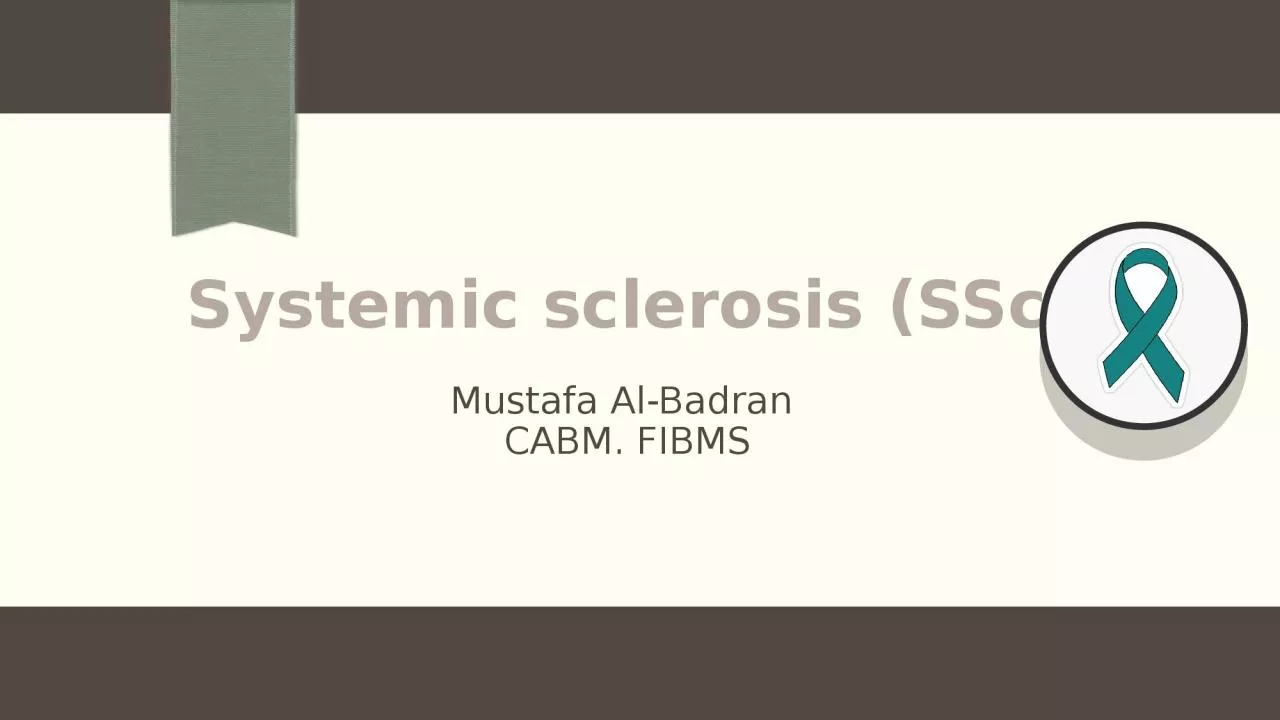

Mustafa AlBadran CABM FIBMS Epidemiology Pathophysiology Clinical Features Skin Initially there is nonpitting oedema of fingers and flexor tendon sheaths Subsequently the skin becomes shiny and taut and distal skin creases disappear and with capillary loss ID: 1014994
Download Presentation The PPT/PDF document "Systemic sclerosis (SScl)" is the property of its rightful owner. Permission is granted to download and print the materials on this web site for personal, non-commercial use only, and to display it on your personal computer provided you do not modify the materials and that you retain all copyright notices contained in the materials. By downloading content from our website, you accept the terms of this agreement.
1. Systemic sclerosis (SScl) Mustafa Al-Badran CABM. FIBMS
2.
3.
4. Epidemiology
5. Pathophysiology
6. Clinical Features
7. SkinInitially, there is non-pitting oedema of fingers and flexor tendon sheathsSubsequently, the skin becomes shiny and taut, and distal skin creases disappear and with capillary loss
8.
9. The face and neck are often involved, with thinning of the lips and radial furrowingSkin involvement restricted to sites distal to the elbow or knee is thus classified as lcSScl Involvement proximal to the knee and elbow and on the trunk is classified as ‘diffuse disease’ dcSScl
10. Raynaud’s phenomenonUniversal and precede other features by many yearsCause critical tissue ischaemia, leading to localized distal skin infarction and necrosis
11.
12.
13. Musculoskeletal Arthralgia and flexor tenosynovitis Restricted hand function is due to skin rather than joint disease and erosive arthropathy is uncommon Muscle weakness and wasting (Myositis )
14. Gastrointestinal involvementOesophagus involvement lead to reflux with erosive esophagitis (Smooth muscle atrophy and fibrosis in the lower two-thirds) Stomach involvement lead to early satiety and outlet obstructionRecurrent occult upper gastrointestinal bleeding may indicate a ‘watermelon’ stomach (antral vascular ectasia; up to 20% of patients) Small intestine involvement may lead toMalabsorption due to bacterial overgrowth Intermittent bloating, pain or constipationPseudo-obstruction (due to autonomic neuropathy )
15.
16. Pulmonary involvementPulmonary hypertension complicates long-standing disease and is six times more prevalent in lcSScl than in dcSSclInterstitial lung disease is common in patients with dcSScl who have topoisomerase 1 antibodies (Scl70)
17. Renal involvementHypertensive renal crisis (main causes of death ) characterised by rapidly developing accelerated phase hypertension renal failureHypertensive renal crisis is much more likely to occur in dcSScl than in lcSSclpatients with topoisomerase 1 and RNP antibodies Treatment by ACEi
18.
19. Investigations ANA positive in about 70%Topoisomerase 1 (Scl70) positive in about 30% of patients with dcSScl Anticentromere antibodies positive in about 60% of patients with lcSSclHigh-resolution lung CT is recommended if interstitial lung disease suspected. If pulmonary hypertension is suspected by transthoracic echocardiography and lung function tests, right heart catheter measurements should be arranged
20. Management
21. Raynaud’s Phenomenon and Digital Ulcers
22.
23. Gastrointestinal ComplicationsOesophageal reflux proton pump inhibitors Bacterial overgrowth Rotating courses of antibiotics (e.g. Rifaximin, a tetracycline and metronidazole), Dysmotility/ Pseudo-obstruction metoclopramide or domperidone
24. Hypertensive Renal Crisis & HypertensionAggressive treatment with ACE inhibitors is needed, even if renal impairment is present.
25. Joint InvolvementAnalgesics and/or NSAIDsLow-dose Methotrexate
26. Progressive pulmonary hypertensionEarly treatment with bosentan is requiredIn severe or progressive disease, heart–lung transplant may be considered.
27. Glucocorticoids and (pulse intravenous) cyclophosphamideInterstitial Lung Disease
28. Prognosis